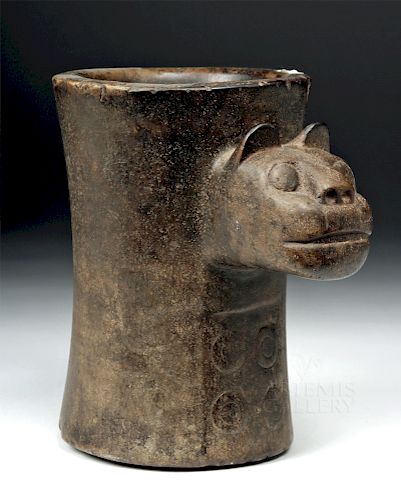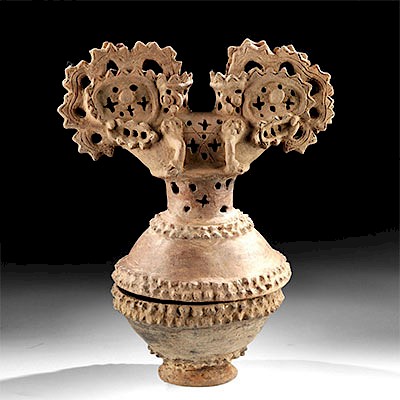Important Tiwanaku Stone Kero w/ Jaguar & Spots
Lot 122d
About Seller
Artemis Fine Arts
686 S Taylor Ave, Ste 106
Louisville, CO 80027
United States
Selling antiquities, ancient and ethnographic art online since 1993, Artemis Gallery specializes in Classical Antiquities (Egyptian, Greek, Roman, Near Eastern), Asian, Pre-Columbian, African / Tribal / Oceanographic art. Our extensive inventory includes pottery, stone, metal, wood, glass and textil...Read more
Categories
Estimate:
$18,000 - $27,000
Absentee vs Live bid
Two ways to bid:
- Leave a max absentee bid and the platform will bid on your behalf up to your maximum bid during the live auction.
- Bid live during the auction and your bids will be submitted real-time to the auctioneer.
Bid Increments
| Price | Bid Increment |
|---|---|
| $0 | $25 |
| $300 | $50 |
| $1,000 | $100 |
| $2,000 | $250 |
| $5,000 | $500 |
| $10,000 | $1,000 |
| $20,000 | $2,500 |
| $50,000 | $5,000 |
| $100,000 | $10,000 |
| $200,000 | $20,000 |
About Auction
By Artemis Fine Arts
Aug 22, 2019
Set Reminder
2019-08-22 10:00:00
2019-08-22 10:00:00
America/New_York
Bidsquare
Bidsquare : Fine Ancient | Asian | Ethnographic Art
https://www.bidsquare.com/auctions/artemis-gallery/fine-ancient-asian-ethnographic-art-4348
Featuring classical antiquities, ancient and ethnographic art from cultures encompassing the globe, plus fine art. Egyptian, Greek, Roman, Etruscan, Near Eastern, Asian, Pre-Columbian, Native American, African / Tribal, Oceanic, Spanish Colonial, Russian, Fine Art, so much more! Artemis Fine Arts info@artemisfinearts.com
Featuring classical antiquities, ancient and ethnographic art from cultures encompassing the globe, plus fine art. Egyptian, Greek, Roman, Etruscan, Near Eastern, Asian, Pre-Columbian, Native American, African / Tribal, Oceanic, Spanish Colonial, Russian, Fine Art, so much more! Artemis Fine Arts info@artemisfinearts.com
- Lot Description
Pre-Columbian, Bolivian highlands, Lake Titikaka region, Tihuanaco / Tiwanaku ca. 400 to 900 CE. A substantive kero form vessel, carved from a stone of rich chocolate brown and umber hues, with a projecting jaguar effigy head emerging from one side, the concave walls smooth with the exception of the neck below the wild feline's head which is elegantly decorated with four incised concentric circles symbolizing the spotted coat of the jaguar - as well as a vertical arrangement of five similar motifs on a raised panel opposite the head that perhaps represents the animal's tail. The jaguar's spotted coat had a practical purpose in that it helped camouflage the wild cat in the jungle; however, it was also believed to symbolize the starry night sky - particularly fitting as the jaguar was nocturnal. The sculptor of this piece successfully created an expressive countenance on the wild feline; just look at those bulging eyes, that slightly open mouth appearing as if gritting his teeth, those alert and erect ears, and that snarling snout! Size: 5.5" in diameter x 8.125" H (14 cm x 20.6 cm)
The jaguar symbolized power and might throughout the Pre-Columbian world. Warriors, rulers, hunters, and shamans alike associated themselves with this king of beasts, the largest and most powerful feline in the New World. Furthermore, the principal god of the earlier Moche wears a headdress adorned with a jaguar head and paws, and important mortals donned similar headdresses. The Huari, having assumed much of the territory of the earlier Moche peoples, were most likely influenced by the Moche's practices and beliefs.
A nocturnal animal, the jaguar sleeps in caves and dark places and creeps quietly in the forest, evoking great mystery. So, oddly enough, few Moche and Huari artists would have actually seen jaguars as they are not indigenous to the coast. Jaguars prefer moist forest conditions. However, scholars believe that some cubs were transported over the mountains for Moche rituals, and it is also possible that some jaguars wandered down the coast.
Provenance: private Harrisburg, Pennsylvania, USA collection acquired before 1995
All items legal to buy/sell under U.S. Statute covering cultural patrimony Code 2600, CHAPTER 14, and are guaranteed to be as described or your money back.
A Certificate of Authenticity will accompany all winning bids.
We ship worldwide and handle all shipping in-house for your convenience.
#124770Normal surface wear commensurate with age. Old nicks to the rim and periphery of base.Condition
- Shipping Info
-
All shipping is handled in-house for your convenience. Your invoice from Artemis Gallery will include shipping calculation instructions. If in doubt, please inquire BEFORE bidding for estimated shipping costs for individual items.
-
- Buyer's Premium



 EUR
EUR CAD
CAD AUD
AUD GBP
GBP MXN
MXN HKD
HKD CNY
CNY MYR
MYR SEK
SEK SGD
SGD CHF
CHF THB
THB

















